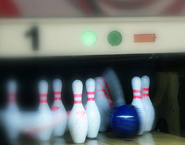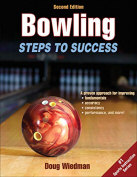Control the Speed of Your Bowling Ball

Controlling your bowling ball speed will help you deal with adverse lane conditions, such as a dry lane.
To be able to maximize your bowling game, you need to learn to properly control your bowling ball speed. Ball speed is one the most important factors in being consistent and scoring high. Being able to adjust the speed of your ball to match the lane conditions will really give you the edge you need to win games. You may arrive at your bowling alley and find your lane is excessively oily. Slowing your ball down when your lane is really oily is the key to getting higher scores. Likewise, during long tournaments, the lane may become dryer, and throwing the ball with more speed will help overcome this obstacle. By controlling the bowling ball speed, you will find yourself at a big advantage over those that don’t.
Speeding up the bowling ball
We will start be teaching you to speed up the bowling ball. Throwing the ball faster will help overcome dry lanes, or to just match up better with a particular lane. If you are finding that your ball is breaking a bit too early, you will want to speed up your ball just a little. The trick here is to hold the ball three to four inches higher in your stance than normal. Your normal stance should include holding the ball at waist level, so lifting it up a few inches here should be no problem. Because the ball is going to be released higher, gravity will give you the little bit of extra speed you are looking for. By using gravity over muscle, you are setting yourself up for a repeatable shot. You can throw the ball with your normal force, and let gravity speed up your bowling ball for you.

Raising your ball up before you start your approach will help you speed up your bowling ball.
To begin to overcome even dryer lane conditions, you will need even more speed. If your ball is hooking a fair bit early, we will again need to call on gravity to help us. This means holding the bowling ball anywhere from six inches to a foot from out normal position. Holding the ball this high will change how you swing, so you will probably need to begin your approach a bit further back. If you are holding the ball ten inches higher than normal, you will want to start about ten inches further back. This will naturally make your approach steps quicker than usual to compensate for your new swing. This natural speed increase is a lot easier to repeat than forcing yourself to move quicker from your original starting point. Again, we are using gravity and not muscle to speed up the ball down the lane.
Finally, if you find yourself on a really dry lane, you are going to have to add some muscle. You will again want to start out with the ball about a foot above your normal starting position. The secret here is to apply muscle in a way that it works with gravity, not against it. Only apply added muscle after the peak of your backswing. You want to apply muscle to only the downward portion of your swing. Increase the power gradually as your swing moves down until you release the ball. You will want to be sure to quicken your approach, because once you start applying the added pressure downward, the ball will naturally move toward the lane faster than normal. You may need to also open your wrist a bit if you find your ball is hooking too much due to the added revolutions now on your ball.
And there you have it. With these tips to speed up your bowling ball, you are ready for dry lane conditions. But what if you find yourself on an extra oily lane?
Slowing down the bowling ball

Lowering your bowling ball will slow it down, helping on oily lanes.
If you are finding your bowling ball skidding right past the break point, you are on a lane that has more oil than normal. The only way to compensate for this situation is to slow down your bowling ball. By slowing down your ball, your ball will have less momentum, therefore gripping earlier and hopefully on its normal breakpoint. So how do you slow down your bowling ball?
Just like adding more speed to a ball, we will use our good old buddy gravity to help. This means holding the ball lower during our approach. Depending on how much speed you want to take off the ball, you should lower it anywhere from two inches to a foot. Another good tip to follow here is bending a little at your knees as well.

With a little practice, you will learn to control your ball speed.
You will also want to start your approach closer to the foul line. Move up approximately the same distance you have lowered your ball. If you are finding that you really need to slow your ball down, make sure to not have a strong follow-through. Just let your arm swing naturally with the ball. No muscle needed here.
These ball speed tips will really help you control your ball speed, but they will take a lot of practice to master. In time, you will be able to add or subtract just tiny amounts of speed from your ball to get it to break where you want it. And by using gravity over muscle, you should be able to repeat the shot consistently. There are more advanced techniques when it comes to controlling ball speed. If you really want to step your game up, take a look at Bowling For Dummies. This guide has every secret and tip you will ever need to become a great bowler. We use the information in this guide every time we bowl.
The Professional Bowlers Association (PBA) organized in 1958.
